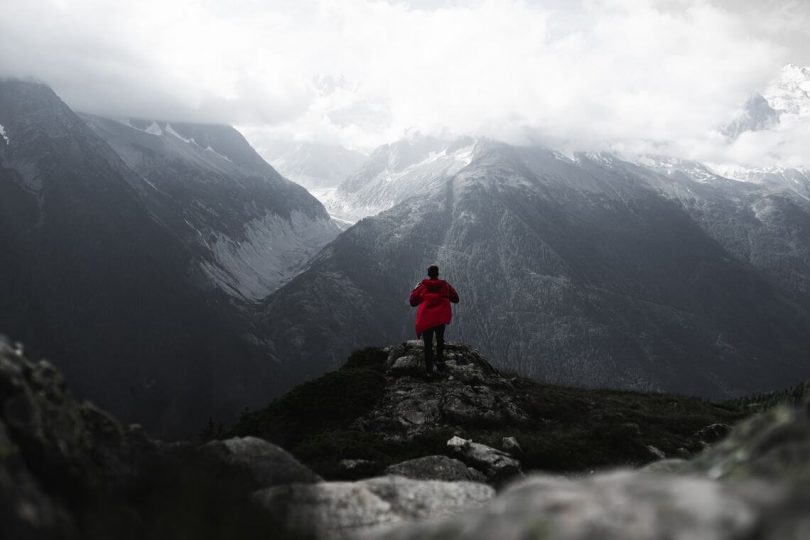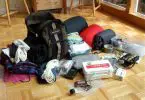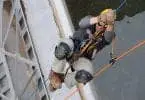With the increase in height when you’re summiting a peak comes a difference in breathing patterns. Your heart rate will also increase since the air is more rarefied and richer in oxygen. Therefore, you’ll feel a lot of pressure on your chest and might find it difficult to breathe.
That’s why you should know how to prevent altitude sickness before setting on your hiking trip, and we’re here to help with all the right info. So we’re not going to tackle just the preventative measures, but also the things you’ll need to do in case you actually get sick.
How Can You Tell if You’re Getting Altitude Sickness?
Apart from knowing what to do to prevent it, it’s wise to recognize the signs and symptoms. You might have already experienced altitude sickness before without being aware of it, and that means you can suffer a worse episode next time around.
These symptoms occur because the blood flow increases with altitude without going back to normal and include:
- Breathing pauses when you’re sleeping
- Difficulty breathing when awake
- Dizziness
- Nausea
- Palpitations
- Tiredness
- Troubles sleeping
Besides, it’s good to know if you have altitude sickness in order to make sure you avoid it getting worse. So to make sure that doesn’t happen, you should:
- Take the medicine your doctor prescribed.
- Get plenty of rest, at least a day or two.
- If you’re not seeing an improvement in your symptoms, climb down to the closest base camp.
If you’re not following these steps, you can get a swelling of your lungs and brain, which is called an edema. The signs this happens begin with increased:
- Blood pressure
- Heart rate
- Ventilation
In the case of cerebral edema, your symptoms might look like:
- Confusion
- Difficulty focusing
- Meaning to do one thing and doing another
- Memory issues
- Stammering
- Stuttering
- Weird behavior
Signs of pulmonary edema include:
- Faintness
- Gray-bluish tint of your eyes, mouth, and fingers.
- Pain in the chest
- Persistent, dry cough
- Trouble breathing
- Wheezing
Unfortunately, all that can get as bad as:
- Pulmonary hypertension
- Heart failure
If you’re already feeling pretty sick and want to avoid certain death, we advise you to:
- Make sure you’re hydrated.
- If you can climb down yourself, do it with assisted help.
- Do oxygen inhalations from the tube. You should have one of these with you if you’ve set on a dangerous trail.
- Ask people to carry you down immediately if you can’t move.
After we’ve seen what you can do to prevent the worst-case scenarios from developing any further, let’s discuss how you can stop them from happening altogether.
Find Out if You’re OK
Doing bloodwork before going on prolonged hikes or other out-of-the-ordinary trips should be mandatory. That’s especially important if you haven’t climbed a mountain at over 8,000 feet by now or if you already know you have an issue with heights.
If that happens, the red blood cells won’t be able to convey the needed oxygen from the air to your lungs. So your GP can recommend checking some indicators of anemia, which is a deficit of red blood cells or iron in your blood. Some of these indicators are:
- Low content of hemoglobin in your red blood cells
- Low iron and serum ferritin levels
- Low B12 and folic acid levels
- High bilirubin levels
If you have a deficiency in one of these regards, your GP will probably prescribe:
- Taking iron supplements
- Taking complex vitamins with B12 and folic acid
- A diet rich in iron, with lots of green vegetables, eggs, and fish
If you have a lack of calcium in your blood, you might also be more prone to experience altitude sickness. In fact, hypocalcemia can induce dizziness and it’s also linked to anemia, so you need to treat that too.
You should follow your doctor’s advice and take a calcium supplement as well as improve your diet.
What if You’re Not Ok But Still Want to Go?
It’s obvious that if your doctor gives you the go-ahead, there’s little to worry about. But what if you already have your tickets purchased to a trip in Nepal and you’re burning to go, and your bloodwork isn’t great? Depending on how serious your symptoms are, you might be told to forget about it or you might be given some prophylactic drugs.
In case push comes to shove, your doctor might advise you to take:
- Acetazolamide. This is a diuretic medicine that’s great for increasing lunge ventilation.
- Cranberry juice. Apart from its diuretic effects, cranberry juice can be another good source of iron and calcium. This is for very mild symptoms, though.
- Ibuprofen. This is an over-the-counter medicine, but you still shouldn’t take it without talking with your GP first. Some hikers take it before actually climbing up, but we wouldn’t advise that. Ibuprofen reduces swelling and eliminates headaches after they happen, it doesn’t prevent them from happening. But you can still have some of this with you in case of mild to moderate altitude sickness issues.
- Steroids. These are already used in treating severe breathing conditions like asthma. That’s because they have anti-inflammatory properties which help fight back any sort of inflammation of your lung tissues.
Get Ready For It
Apart from making sure you’re as healthy as it gets, you should also make sure you can withstand the climb.
Learn breathing techniques
If you’re not breathing properly during your climb, you’re increasing the risk of hyperventilation. That means you’ll be more tempted to take small, shallow breaths, which will make you dizzy fast, get you tired and impatient. That can either trigger the altitude sickness or make your symptoms worse.
Some breathing techniques that help in that regard are:
The 4-3 method
This is a method to avoid altitude sickness altogether. The basic thing is that you’ll breathe in four times while taking four steps up, then exhale three times while climbing another three steps.
That’s great for helping you set a good, steady pace, without hurrying up and getting you out of breath. It’s how you stay fresh and prevent tiredness, or at least postpone it. It’s also a good way to get your body used to the more rarefied air at the bigger heights.
The 6-7 method
If you’re starting to get dizzy and to experience some altitude sickness, it’s a good thing to stop for some time. At this point, you should make your breathing even slower, inhale for six breaths and exhale for seven breaths.
This is a great way of calming a very rapid heartbeat as well as getting more oxygen in your system. You’ll notice that the exhale is longer in this method, which is great for settling an anxious mind, not just regulating an uneven breathing pattern.
The “Breathe with every body part” method
If you’re already very sick, you should lie down and try to relax. Close your eyes and take a deep breath in, while you imagine your feet unwinding, then exhale. Do the same thing progressively for your whole body, following with your calves, thighs, hands, core, upper back, chest, and head.
Spend enough time loosening up your chest area and head, since this is where you’ll feel the effects of altitude sickness more. You won’t do any counts with this method because you need to focus your mind on relaxing your body.
Exercise
You should also squeeze in some exercise in your routine that will help you decrease the chances of getting altitude sickness. Some of the best are:
- Yoga. This is great for learning relaxation techniques to make sure you have the right mood for climbing. It’s also a good way to get some toning done and fortify your core.
- Pilates. All the Pilates exercises are based on slow, control breathing and keeping your core solid. You’ll learn how to exhale at the most difficult part of a certain exercise, which is a good way to overcome the negative effects of more intense workouts.
- High–intensity interval training. This is an anaerobic exercise that will teach you to breathe well even when you’re doing a lot of effort. Since you’ll combine periods of intense exercises with rest, your heart rate will know how to settle and your breathing can become more regular.
- Cardio. All forms of cardio exercises are shown to decrease your active heart rate in the long run. That means you can do a strenuous hike without feeling palpitations or breathing difficulties since your heart can pump the necessary amount of blood without getting tired.
- Diving. If you like swimming, now you can also learn how to love diving. Besides, since there will be a huge amount of water above you, your lungs will feel a similar strain as they do at high altitudes.
- Practice hikes. If you’re not used to hiking at all, you should take your time and start slow, with easy hikes that get your body ready. Don’t try to climb at 9,000 feet from the get-go, just increase the elevation a bit each time you hike. But that means making regular trips, so you should probably take a small vacation before your big trip. If you can’t do that, you should at least hike every weekend for a few months before the hike.
On the trail
These are the preventative measures you can take at home. But it’s also important to know how to avoid altitude sickness when you’re actually doing the climb.
Fight the time zone
If you’re planning an intense hike in a different country you’ll probably travel to a different time zone. That equals lack of sleep and more tiredness, which can trigger your altitude sickness.
To avoid that, you should rent a hotel room where you can check in right after you’ve stepped out of the plane. That will give you at least a good night’s rest to catch up on your sleep before your big hike. You can also spend a few more days there too if you’re planning a really intense hike and explore the area.
Acclimatize
This is essential regardless of how high you’re climbing. Generally speaking, anything above 9,000 feet is considered problematic and most people can do fine with hikes up to that height. But don’t take that for granted, you can still get altitude sickness if you’re moving too fast. So the antidote is easy: just move slower. Hiking isn’t a competition, and unless you’re being chased by a rabid bear, don’t run up.
If you’re planning to climb a very high peak, you should rest a bit before that. Depending on how high that summit is and how long it will take you to get there, you should stop at the base camp anywhere between a few hours to a few days.
Stop along the way
Apart from that, you should also stop frequently to prevent you from getting sick. So don’t wait until you can’t see straight or can’t breathe to know it’s time to give it a rest.
You can organize your pit stops:
- According to time. Stop every 20 minutes to catch your breath.
- According to the climb. Stop for 20 seconds before and after each more strenuous portion. Stop for more time if you don’t feel you’ve recovered completely.
- According to the map. Set some stopping points before actually climbing up so you can check each one off and ensure you’re getting proper rest. This is great for more experienced hikers that need to cover a fixed distance each day.
Choose your camping spots wisely
Even if you frequently stop along the way, there’s still a maximum height your body can take each day. That depends on how high you’re planning to go:
- 6,000 – 9,000 feet in one day is fine if that’s the maximum elevation.
- 1,500 feet per day if your destination is located at more than 9,000 feet.
That means you should make sure you have plenty of camping spots available on the way there so you can at least spend the night before the next climb. However, if you’re not feeling that great, you can take at least a day off to acclimatize at the camp you’ve gotten to.
Hydrate
Water has a number of characteristics that help you alleviate and prevent altitude sickness like:
- Keeps all your cells, tissues and organs healthy.
- Prevents inflammations.
- Reduces headaches.
- Reduces the risks and effects of dizziness.
So you should:
- Make sure you’re already hydrated before the trip.
- Drink at least 3-4 liters of water each day when you’re climbing, and 2 liters/ day on your rest days.
- Avoid drinking alcohol because it makes you hyperventilate and dehydrates you.
- Continue drinking your daily cup of coffee so you can avoid any headaches.
- Eliminate energy drinks that have a high sugar content and dehydrate you.
Eat well
Make sure you eat the foods that will help you with any issues you might have that can trigger an altitude sickness episode.
So you should:
- Get enough calories. That will give you enough energy to climb up.
- Make sure you feel satiated so you won’t feel faint.
- Get plenty of fibers and carbohydrates. Your body loves to transform these into energy especially because they provide a constant energy input. But the most important thing is they can handle the oxygen in your body better, transporting it to the proper places.
Stay Safe
We’ve given you some general advice on how to prevent altitude sickness, but if you have to treat a severe episode it’s best to follow your doctor’s recommendations.
Staying safe on the trail is your number one priority, so if you’re feeling any sort of discomfort it’s best not to ignore it. Stopping for even a minute or two can actually save your life, so it’s a good thing to listen to your body and understand that prevention is easier than treatment.
Featured Image Source: https://unsplash.com/photos/NCFCbcNVSVQ







